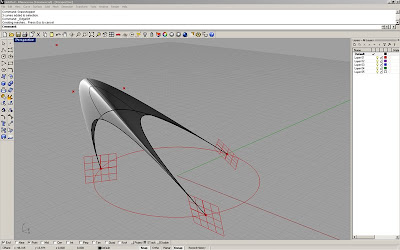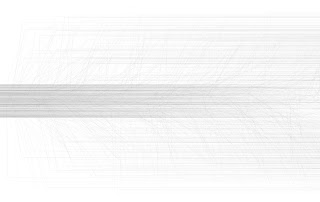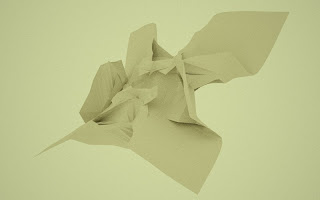
Friday, November 27, 2009
Processing: Professional Dev Review

Tis the season for 'Professional Development Review'. A moment to sit down with the design leadership of my studio and talk about what I've done, what hasn't been acheived and what I'm looking for in both the near and distant future.
Like visiting Santa.
Occupational Santa. Without elves. At any rate, I reviewed the 'official' paperwork and decided to script my response instead of spending time in M$Word. :)
Here's to not getting a lump of professional coal.
Thursday, August 13, 2009
Grasshopper: Paneling
Sunday, May 31, 2009
Grasshopper: For the (office) Masses!


I've been asked to prepare a short 'inspirational' presentation for my office. The topic, not surprisingly, is Grasshopper and I've put together the above study for this purpose. More than anything, I hope to use it as a platform for launching 'variable design' as a conceptual platform to further (our) use of parametric design... A quick narative on how I've worked concept(s) into a system and relationship of variables within Grasshopper.
Generative Sketch below. It happened to be sitting on my (virtual) desktop.

Labels:
division,
form,
Grasshopper,
module,
parametric,
surface
Saturday, May 30, 2009
Grasshopper: Between Skins

This weekend? Skinning studies.
Lofting (parametric) curves, then dividing these equally into # segments. Each common point is linked between the two skins with a generic beam connecting the two... next up? Study of how these connecting elements should logically vary in thickness, per location, loading, etc.
Enough for one night.
Friday, May 22, 2009
Grasshopper: Output


It's about the process. There's nothing interesting nor innovative about this as a formal exercise, ribbed/lasercut models being several years dated. The big difference here, for me and as a learning process, is how little time was spent setting up fabrication. In similar projects I've spent an enormous amount of time constructing logic(s) to inform jointing, layout,etc... but in this case I ran only a few simple scripts. Between semi-automated output and parametrically derived geometry, the time required for iterative design study is much more palatable. And that's good for everyone.
Enjoy the long weekend...
Sunday, May 17, 2009
Grasshopper: Building, Learning


First off, big thanks to V. Soler from 'http://www.grasshopper3d.com/forum' for helping me out with a component that I couldn't implement correctly. Secondly, more output. It's nothing exciting but it -does- represent my own progress with the Grasshopper.
The second image represents my most comprehensive study to date. It began with a series of (3) catenary curves, deformed toward a common, editable point. Each defining curve is anchored to vertices of an equilateral triangle. A mesh is finally applied, defined by each catenary. Theoretically, it's the first output with basis in structure, gravity, etc.
Thursday, May 14, 2009
Grasshopper: Now = Generative Components

I've been playing around with Grasshopper a bit more and while I don't 'understand' it in any significant way, I'm at least to the same level with it as a program/tool as I ever reached with Generative Components. It would be a dis-service to call my faculty with either as 'functional', but I'm fine with 'experimental'. I'll continue my early-morning / post-work studies...
Labels:
design,
experimental,
Grasshopper,
parametric
Monday, May 11, 2009
Grasshopper: <3 the GUI.


100% spirals + sine waves for now.
Architecture later. Hopefully.
Architecture later. Hopefully.
Labels:
design,
Grasshopper,
modeling,
parametric,
Rhino,
script
Saturday, April 11, 2009
Weekend Project: Floral Smoothie
 Creatively, one of my roommates used the glass upper of our blender as a vase. I couldn't pass up the opportunity to assemble the whole thing and shoot a few images pre-work, post-coffee earlier this week. Were I into video, blending & recording may have been an option.
Creatively, one of my roommates used the glass upper of our blender as a vase. I couldn't pass up the opportunity to assemble the whole thing and shoot a few images pre-work, post-coffee earlier this week. Were I into video, blending & recording may have been an option. A quick little graphic exercise for Saturday morning... Enjoy.
In the spirit of Spring.
Despite the rain.
Tuesday, March 24, 2009
EVENT: Cut & Paste 2009

This past weekend (21.03.2009) I stopped in on "Cut & Paste 2009", an annual worldwide design competition. 4 designers are pre-selected, given a theme and 15 minutes to produce work. 2D, 3D and Video competitions were held.
Some great work was produced. As an audience member, the most interesting aspects where the individual workflows and directions taken by each artist. Some designs were very similar, begging the question of how a 'theme' also implies a given resolution... but in other cases the end results were wildly different.
If nothing else, I can safely say that I am much, MUCH slower in CS4/Max than any of the contestants. Perhaps my office should start giving us restricted 'clock time' for our projects: "Design the vertical circulation in 15 minutes!" "Egress diagrams, go!"... every working day becomes a series of 32 15min design charrettes.
Friday, March 20, 2009
Script: Old pattern, new colors

A B+W version of this had been my background for some time. Needing some time away from monocromatic themes, I added a few bits of code for random color values and re-ran the script.
int R = int(random(100,255));
int G = int(random(100,255));
int B = int(random(100,255));
fill(R,G,B,90);
10000x itterations shown above.
Sunday, March 15, 2009
Script: It's been a long week.
A colleague of mine spent some time really, really trying to get a certain facade pattern into a project some months back. The studies were great, but the concept didn't end up impacting the design. Apparently it impacted me, and I've oft thought about how to replicate/study/iterate upon the idea.



Frames #00000001, #00001000, #00359000 follow.



Saturday, February 28, 2009
Script: Triangles Generated in 3D
Tuesday, February 17, 2009
Sunday, February 8, 2009
Generative Components: 3
GC Sample.
Basic output, but interesting nonetheless.
The surface below is built from a field of lines, each of which has a variable length based on the location of a single control point. Translating the location of this point alters relationship to the field, each line then changing in response. The variables driving each line are similar, yet result in a surface that neither rises nor falls uniformly, but undulates in a seemingly random manner. This has been simplified to a series of polygons, easily output to a Fabrication file.
Generative Components: 2
The last post didn't center on Generative Components as I'd intended. Perhaps trying to chronicle something after spending an entire day learning it isn't the way to go. Perhaps talking about something, anything, directly after isolating yourself to it isn't the strategy. Take time to think and then formulate your thoughts. I digress.
The potential in GC is amazing. Those involved in formal design can tell you how much time is taken to refine, adjust and operate upon iterations of an idea. Weeks are easily spent building, editing and reworking studies both physical and digital. A tool that allows you alternate methods through this workflow would be a very fortunate thing. Contrasty, any tool is packaged with inherent limitations. Some see script-, code- or program- based design as limiting, taking away the freedom 'intrinsic' of pen, paper and creative thought. Indirectly, I agree. But what I find limiting is the enormous investment of time required to become minimally effective with any tool. Technology progresses; How many tools can or should we reasonably learn?
Generative Components? Maya? 3DsMax? Rhino, Maxwell, FormZ, Catia, Photoshop, Illustrator, Director, AutoCAD, Microstation, Ecotect, Revit? This isn't a new problem so much as a new medium. Watercolor, Welding, Charcoal, Ink(?).... each is a tool.
I'm working to wield a few more.
Labels:
design technology,
generative components,
rants
Saturday, February 7, 2009
Generative Components: 1

I've never been TO Hoboken. I've passed directly through it by foot, car and train, but never stopped to take it in. Imagine my surprise this morning as I found myself getting ready to spend the entire day there. 9 hours, a SIT lecture hall and Generative Components.
GC? Well.... it's complicated. In a good way. :P
Labels:
generative components,
jersey,
modeling,
parametric
Monday, February 2, 2009
script: triangulation
processing:
In exploring Processing, I find myself asking 'how can I make this more interesting?
In exploring Processing, I find myself asking 'how can I make this more interesting?
The constraint, one entirely on my part, is that of dimensionality. Processing provides quick and gratifying graphic stimulus, but hasn't allowed movement in 3-dimensions as I'd like. Part of it is ability. I'm an architect, not a programmer. The amount of time that I can reasonable dedicate to learning new scripting languages (new? any?) is pretty minimal.
The eventual goal would be to take a randomized (Triangle_Strip) as below, integrate some sort of Z-axis variation and present the work through perspective. At this point it's a tall order. More study to be done...

script: texture
processing:
a pattern study of texture.
each circle is connected via a thin transparent line which, through iteration, creates an additive visual grain. below is the result of 50k loops of this simple function.


int xW = 3360;
int yH = 1050;
void setup(){
background(150);
size(xW,yH);
}
void draw(){
// for (int i = 0; i <>
//noLoop();
int xRAN = int(random(0,xW));
int xCIR = int(random(10,100));
int xLEG = int(random(50,1200));
int xLEG2 = int(random(50,1200));
int rVAL = int(random(-8,8));
// drawINSTANCE (x-position, circle-radius, legnth)
drawINSTANCE(xRAN, xCIR, xLEG, xLEG2, rVAL);
// }
}
void drawINSTANCE(int xRAN, int xCIR, int xLEG, int LEG2, int rVAL)
{
//display settings
int R = int(random(100,255));
int G = int(random(100,255));
int B = int(random(100,255));
smooth();
stroke(0,20);
fill(255,90);
//end settings
//start
pushMatrix();
translate(xRAN,0);
line(0,0,0,xLEG);
ellipse(0,0,xCIR/8,xCIR/8);
pushMatrix();
translate(0,xLEG);
ellipse(0,0,xCIR/6,xCIR/6);
pushMatrix();
rotate(PI/rVAL);
line(0,0,0,xLEG);
translate(0,xLEG);
ellipse(0,0,xCIR/3,xCIR/3);
popMatrix();
popMatrix();
popMatrix();
if((frameCount % 10000) == 0) {
saveFrame("02test-########.tif");
}
}
Sunday, February 1, 2009
Thursday, January 1, 2009
Subscribe to:
Posts (Atom)









